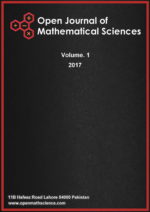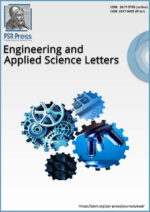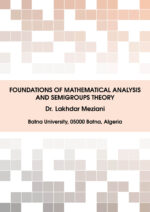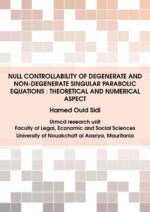Ptolemy Scientific Research Press (PSR Press)is a highly regarded publisher of scientific literature dedicated to bringing the latest research and findings to a broader audience. With a focus on cutting-edge research and technology, Ptolemy Scientific Research Press offers a range of publications catering to professionals, researchers, and student’s needs. Whether looking for information on the latest breakthroughs in physics, biology, engineering, or computer science, you can trust Ptolemy Scientific Research Press to deliver insightful, accurate, and engaging content. With its commitment to quality, accessibility, and innovation, Ptolemy Scientific Research Press is an essential resource for anyone interested in science and technology.

Latest Published Articles
TCMS-Vol. 1 (2021), Issue 1, pp. 16 – 20 Open Access Full-Text PDF
Ataur Kamal Rashid, Mozafar Khazaei
Abstract:The aim of this paper is to diagnose pre-eclampsia with spot urine albumin-creatinine ratio (ACR). Our study comprised of one hundred ten pregnancies within 20-28 weeks of gestation. Spot mid- stream urine sample was collected from all pregnant females and urine ACR estimation was done using immunoturbidimetric microalbumin method and modified Jaffe’s method for creatinine estimation. We found sensitivity of 90.4%, specificity of 98%, PPV of 91.6% and NPV of 97.2%. Systolic blood pressure in unaffected subjects was 110.2 mm Hg and in pre- eclamplsia was 152.6 mm Hg. Diastolic blood pressure in unaffected subjects was 78.4 mm Hg and in pre- eclamplsia was 96.8 mm Hg. In unaffected subjects, 4.5% showed positive test and 95.5% showed negative test. In pre- eclampsia subjects, 87.2% showed positive test and 12.8% showed negative test. Mann Whitney U test showed significant difference between two (Significant, P< 0.05). It has been observed that the role of urine albumin creatinine ratio in detection of Pre-eclampsia is evident. A higher sensitivity and specificity revealed its usefulness in early detection.
TCMS-Vol. 1 (2021), Issue 1, pp. 11 – 15 Open Access Full-Text PDF
Mustafa Soliman, Wail Al Beig, Mohammed Usman Ali
Abstract:Aim: To assess various risk factors for development of CHD among patients. \Methodology: Seventy- eight patients of either sex were included. Various parameters such as age, gender, cardiac markers, family history, history of alcohol intake and smoking was recorded. Results: There were 32 patients >45 years of age and 46 below 45 years of age. Out of 78 patients, females were 27 and males were 51. It was found that 26 had primary education, 37 had secondary and 15 had higher education. 38 were employed and 40 were non- employed. 42 were married and 36 were unmarried. Family history was positive in 51 and negative in 26. 20 had hypertension, 36 had CHD and 22 had both HTN & CHD. 45 had habit of smoking, 47 had alcoholism and 40 had no physical activity. A significant difference was observed (P< 0.05). Conclusion: Common risk factors for CHD was obesity, hyperglycaemia, family history, high LDL- C, ALT level, smoking, alcoholism and lack of physical activity.
TCMS-Vol. 1 (2021), Issue 1, pp. 6 – 10 Open Access Full-Text PDF
Ankush Sathiyan, Hari Mahajan Jain, Sarfaraz Alam Khan
Abstract: Aim: To study 82 cases of nasal polyposis undergoing functional endoscopic sinus surgery (FESS). Methodology: Our study comprised of 82 patients presenting with the symptoms of nasal polyposis (38 male patient, 44 female patients). All managed with FESS. Parameters assessed were NOSE score and nasal endoscopy score pre- operatively which was compared with post- operative score at 6 months and 12 months. Results: We found pre- operative NOSE score was \(65.2\pm 5.7,\) at 6 months was \(28.4\pm 4.1\) and at 12 months post- operatively was \(24.2\pm 3.6.\) We found pre- operative nasal endoscopic score was 6.02, 6 months score was 3.1 and 12 months score was 2.5. Conclusion: Patients nasal endoscopy score and NOSE symptom score was improved after treatment. Functional endoscopic sinus surgery is treatment of choice in patients with chronic rhinosinusitis with nasal polyps.
EASL-Vol. 4 (2021), Issue 1, pp. 80 – 97 Open Access Full-Text PDF
Anders S.G. Andrae
Abstract: In this decade there will an unprecedented growth of generated data, computations, instructions, and operations. This growth may not compromise clean air, clean water and a sustainable energy and material usage, but rather facilitate these prerequisites for flora and fauna. There are many indications (expected trends and estimates) showing that the Internet Sector will be able to provide solutions to other Sectors such as Buildings, Transportation and Industry which will help reduce the total global consumption of energy and materials. For instance, products are replaced by virtual services e.g. by using e-readers instead of paperbacks, and transportation is avoided by online shopping or Internet meetings. This is more resource and energy efficient than before and entire sectors, like transport, industry, and agriculture can be optimized. Internet may foster new sustainable lifestyles which can lower the affluence despite certain rebound effects. The underlying idea is that e.g. human-related global greenhouse gas (GHG) supply can be significantly halted if existing and developing ICT Solutions are used in other sectors (and in the Internet infrastructure itself) to cause a handprint. Such solutions include products-sold-as-services, smart Grid and smart metering. Compared to earlier approaches, the 2020 transformative effects on smart work, land use and smart circularity are included in the discussion, as well as consequential LCA modelling. Internet’s handprint will be 4-7 times its footprint in 2030. The handprint is highly dependent e.g. on how large share of the buildings can adopt smart metering and the product to service rate. Internet will in itself use intelligent ICT solutions as well as neuromorphic, reversible and superconducting computing as well as nanophotonics to mitigate its own material and energy use. However, more importantly the intelligent ICT solutions should be used in the rest of the society to reach efficiency goals. Power saving is a highly efficient strategy for cost reduction in the Internet Sector itself and beyond.
ODAM-Vol. 4 (2021), Issue 1, pp. 25 – 28 Open Access Full-Text PDF
Ivan Gutman
Abstract: The energy of a graph is the sum of absolute values of its eigenvalues. The nullity of a graph is the algebraic multiplicity of number zero in its spectrum. Empirical facts indicate that graph energy decreases with increasing nullity, but proving this property is difficult. In this paper, a method is elaborated by means of which the effect of nullity on graph energy can be quantitatively estimated.
TCMS-Vol. 1 (2021), Issue 1, pp. 1 – 5 Open Access Full-Text PDF
Nidhi Sharma
Abstract: Aim: To calculate size, shape and position of mental foramen. Materials & Methods: 50 dry human mandibles of either gender (20- females, 30- males) were included. The position of mental foramen in horizontally was calculated based on classification proposed by Bokhari. The vertical position was divided into six types using the modified Ngeow and Yuzawati criteria. Size was measured both vertically and horizontally with the help of vernier caliper and expressed as mean. Results: Most common horizontal position was II seen in both males (left- 56%, right- 50%) and females (left- 60%, right- 58%). Most common vertical position was 2 seen in males (left- 62%, right- 65%) and females (left- 55%, right- 52%). Most common shape was oval seen in both genders (males- 68% left, 62% right) and (females- 70% left, 72% right). A significant difference was observed \((P<0.05)\). Conclusion: Variation in shape, size and position was observed both males and females, however, most common shape found to be oval and position was II horizontally and 2 vertically in both genders.








